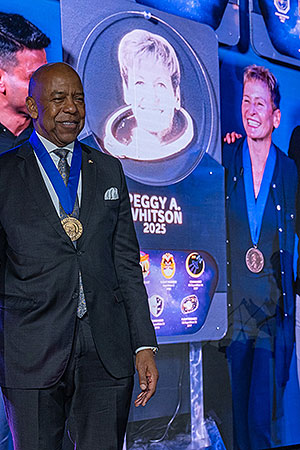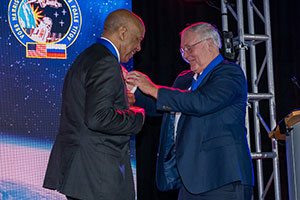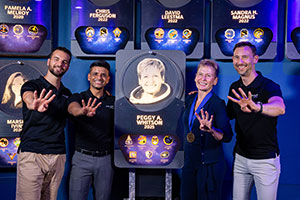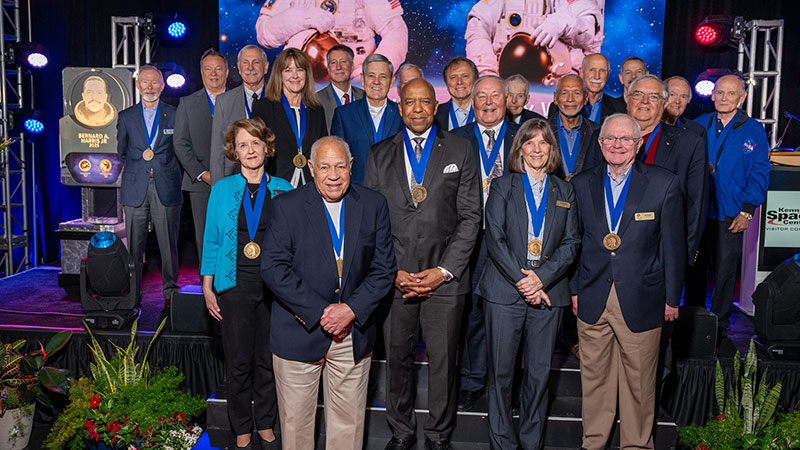 advertisements advertisements
|

|
Two space vets added to Astronaut Hall of Fame as one awaits launch
June 1, 2025 — The U.S. Astronaut Hall of Fame held its annual induction ceremony on Saturday (May 31), but one of this year's two honorees could not attend for a reason unique to all past enshrinements.
Bernard Harris, the first Black astronaut to perform a spacewalk, took to the stage, received his induction medal and unveiled the plaque that will represent him in the hall of fame at NASA's Kennedy Space Center Visitor Complex in Florida. His fellow 2025 inductee, Peggy Whitson would have done the same, but was absent due to needing to be in quarantine ahead of her upcoming fifth launch into space.
Like Harris, Whitson is retired from NASA, but since 2018, has been working for Axiom Space, a Houston-based space services company. She led the company's second mission to the International Space Station in 2023 and is now set to lead its fourth, Ax-4, launching as soon as the second week of this month.
Like the 109 astronauts' displays that are already on exhibit, Harris' backlit plaque included his portrait etched in glass, his name, year of his induction and images of his mission patches. Harris conducted his historic EVA, or extravehicular activity, on the second of his two space shuttle flights in 1995.
"In truth, I didn't know i was the first African American until I got back inside and I got the call that President Clinton wanted to talk to me," said Harris, according to the Orlando Sentinel. "I kind of went like, 'What for?'"
Whitson is the first-ever astronaut to be inducted into the hall of fame while in the midst of carrying out a mission and only the second inductee to still be on active flight status at the time of or after her enshrinement. (Michael Lopez-Alegria, who also works for Axiom Space, was the first in 2021. Mercury astronaut John Glenn, who was in the inaugural class of inductees in 1990, also flew into space after his induction as a space shuttle payload specialist in 1998.)
Not that you would know it by looking at the patches on Whitson's hall of fame plaque. Her upcoming Axiom Space-4 (Ax-4) emblem is missing, as is her prior commercial flight (Ax-2). Based on hall's eligibility requirements, the honor is only open to NASA-trained crew members, which, apparently, now also extends to which missions are acknowledged on the astronaut's display.
Whitson got an early look at her plaque during a private visit to the visitor complex with her three Ax-4 crewmates prior to their entering quarantine.
Prior to flying for Axiom, Whitson set the record for the most cumulative time in space by American, 665 days, as well as set the worldwide record for the most time off the planet by a woman. Those records have only grown as she continues to fly (It is currently at 675 days).
"Harris and Whitson truly represent the courage, adventurous spirit, and dedication to exploration that are vital for success in the space program," Curt Brown, chairman of the Astronaut Scholarship Foundation, which manages the hall's selection process, said in a statement. "With their remarkable achievements and contributions to the field, it's only appropriate to welcome them into the U.S. Astronaut Hall of Fame at the Kennedy Space Center Visitor Complex, where they join the legacy of space trailblazers to receive this prestigious honor."
In addition to Brown and Harris, Saturday's ceremony also included remarks by Therrin Protze, chief operating officer of the visitor complex, and Kelvin Manning, acting director of Kennedy Space Center. Harris was welcomed into the hall and presented his induction medal by 2014 inductee Jerry Ross, who flew on STS-55, Harris' first spaceflight in 1993.
Kent Rominger, who entered the hall in 2015 and like Whitson, served as chief of the astronaut office, formally inducted the veteran space shuttle and space station astronaut in her absence.
"Please know that my heart is with you," said Whiston in a pre-recoded message, which was played Saturday according to the Orlando Sentinel. "It is a privilege to be a part of such an esteemed group of individuals who have dedicated their lives to exploring the unknown,"
Brown (class of 2013), Ross and Rominger were among the more than 30 veteran and active astronauts who attended the ceremony, many of whom also have been inducted into the hall of fame.
The hall was originally proposed more than 30 years ago by the six surviving Mercury 7 astronauts. In addition to being NASA trained, today's nominees need to have made his or her first flight at least 15 years before the induction year, be a citizen of the United States and have completed at least one orbit around Earth. |
|

2025 U.S. Astronaut Hall of Fame inductees Bernard Harris (at left) and Peggy Whitson (via pre-recorded video) during their induction ceremony at the Kennedy Space Center Visitor Complex in Florida on May 31, 2025. (Kennedy Space Center Visitor Complex)

2014 inductee Jerry Ross presents his STS-55 crewmate Bernard Harris with an Astronaut Hall of Fame medal during Harris' induction ceremony at the Kennedy Space Center Visitor Complex on May 31, 2025. (Kennedy Space Center Visitor Complex)

At a private event held before they entered quarantine for their upcoming launch, Peggy Whitson and her Ax-4 crewmates pose with her Astronaut Hall of Fame plaque. (Kennedy Space Center Visitor Complex) |

2025 inductee Bernard Harris (center) surrounded by fellow members of the Astronaut Hall of Fame at the Kennedy Space Center Visitor Complex on May 31, 2025. From left to right: Brewster Shaw, Michael Lopez-Alegria, Curt Brown, Kathy Thornton, Janet Kavandi, Fred Gregory, Kent Rominger, Bob Cabana, Steve Lindsey, Harris, Franklin Chang-Diaz, Jerry Ross, Joe Kerwin, Bonnie Dunbar, Charlie Bolden, Dick Covey, Roy Bridges, Scott Altman, Dan Brandenstein, Bob Crippen and Norm Thagard. (Kennedy Space Center Visitor Complex) |
|

© 1999-2025 collectSPACE. All rights reserved.
|
|

|

|
